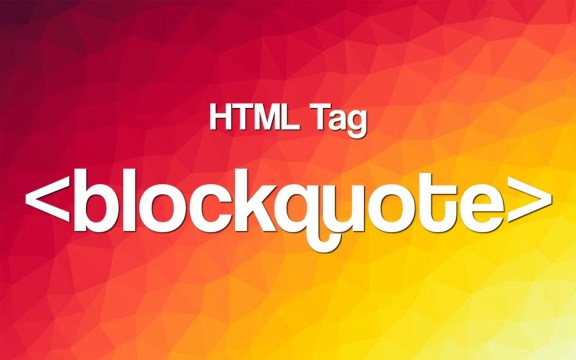The <blockquote> HTML tag is used to indicate that the enclosed text is a longer quotation from another source. Browsers typically render the content inside a <blockquote> tag with indentation to visually distinguish it as a quotation. Here's the basic syntax:
<blockquote>
<!-- Quoted text goes here -->
</blockquote>
Additionally, the <blockquote> tag often includes a cite attribute to specify the source of the quotation. Though not required, it's good practice to include it for proper citation:
<blockquote cite="URL_of_the_source">
<!-- Quoted text goes here -->
</blockquote>
Here's an example of how you might use the <blockquote> tag in HTML:
<blockquote cite="https://en.wikipedia.org/wiki/Albert_Einstein">
<p>Imagination is more important than knowledge. For knowledge is limited, whereas imagination embraces the entire world, stimulating progress, giving birth to evolution.</p>
<footer>— Albert Einstein</footer>
</blockquote>
In this example, the content inside the <blockquote> tag represents a quotation attributed to Albert Einstein. The cite attribute specifies the URL of the source where the quotation was found. Additionally, a <footer> element is used to indicate the author of the quotation.
Syntax and Attributes
The <blockquote> HTML tag is used to define a section that is quoted from another source. Here's the syntax and some common attributes:
Syntax:
<blockquote cite="URL">
<!-- Quoted content goes here -->
</blockquote>
Attributes:
- cite: Specifies the URL of the source of the quotation. This is optional but recommended for providing a reference to the original source. Example:
<blockquote cite="https://www.wikipedia.com">.
Example usage:
<blockquote cite="https://www.wikipedia.com">
<p>This is a quoted text from another source.</p>
</blockquote>
Remember, while the cite attribute is commonly used to provide a URL reference, it doesn't cause the browser to fetch the resource or display it to the user. It's primarily for providing a machine-readable link to the source.
Accessibility Considerations
When using the <blockquote> HTML tag, it's essential to consider accessibility to ensure that users of assistive technologies can understand and navigate the content effectively. Here are some accessibility considerations for the <blockquote> tag:
Semantic Meaning: Properly use the <blockquote> tag to convey the semantic meaning that the content is a quotation from another source. This helps screen readers to announce the quoted text appropriately.
Use of Alternative Text: If the <blockquote> contains images or other non-text content, ensure that appropriate alternative text (alt attribute for images) is provided to convey the content to users who cannot see the visual content.
Citation: Include a citation within the <blockquote> using the <cite> element or the cite attribute. This provides context about the source of the quotation, which can be valuable for users trying to understand the content.
Reading Order: Ensure that the reading order of the content is logical and follows the intended flow, especially when using nested elements within the <blockquote>. Screen readers typically navigate content in the order it appears in the markup.
Styling and Visual Indicators: Use appropriate styling or visual indicators to distinguish <blockquote> content from regular text, but avoid relying solely on visual cues. Ensure that the distinction is also perceivable by users who rely on screen readers or other assistive technologies.
Testing with Assistive Technologies: Test the <blockquote> content with screen readers and other assistive technologies to ensure that it is announced correctly and that users can understand the quoted content and its context.
By considering these accessibility guidelines, you can ensure that content within <blockquote> elements is accessible to a wide range of users, including those with disabilities who rely on assistive technologies to access web content.
→ Utilizing the <abbr> HTML Tag (syntax, attributes, compatibility)
Compatibility and Browser Support
The <blockquote> HTML tag is widely supported across modern web browsers. Here's an overview of its compatibility and browser support:
Browser Support:
-
Google Chrome: Fully supports the
<blockquote>tag. -
Mozilla Firefox: Fully supports the
<blockquote>tag. -
Apple Safari: Fully supports the
<blockquote>tag. -
Microsoft Edge: Fully supports the
<blockquote>tag. -
Opera: Fully supports the
<blockquote>tag. -
Internet Explorer: Fully supports the
<blockquote>tag. It is supported in all versions of Internet Explorer.
Compatibility:
Mobile Browsers: The <blockquote> tag is compatible with mobile browsers across various platforms, including Android and iOS.
Screen Readers and Assistive Technologies: Screen readers and assistive technologies are generally compatible with the <blockquote> tag. They can properly interpret and present blockquoted content to users with disabilities.
Styling and CSS: While the <blockquote> tag itself is well-supported, its appearance and styling may vary depending on the CSS rules applied to it. Developers should ensure consistent styling across different browsers and devices for a uniform user experience.
Semantic Meaning: The <blockquote> tag carries semantic meaning, indicating that the enclosed content is a quotation from another source. This aids accessibility by providing context to users and assistive technologies.
Best Practices:
Accessibility Testing: Perform thorough accessibility testing to ensure that blockquoted content is properly interpreted and presented by screen readers and other assistive technologies. Verify that the content maintains semantic meaning and readability for users with disabilities.
Styling Consistency: Maintain consistent styling for <blockquote> elements across different browsers and devices to ensure a uniform user experience. Test the appearance of blockquoted content in various scenarios to identify and address any compatibility issues.
Use of cite Attribute: When appropriate, use the cite attribute to specify the source of the quotation within a <blockquote> element. This enhances accessibility by providing additional context and attribution for the quoted content.
In summary, the <blockquote> HTML tag enjoys good support across modern web browsers and is compatible with mobile browsers and assistive technologies. By following best practices and ensuring consistent styling, developers can create accessible and user-friendly blockquoted content on the web.
